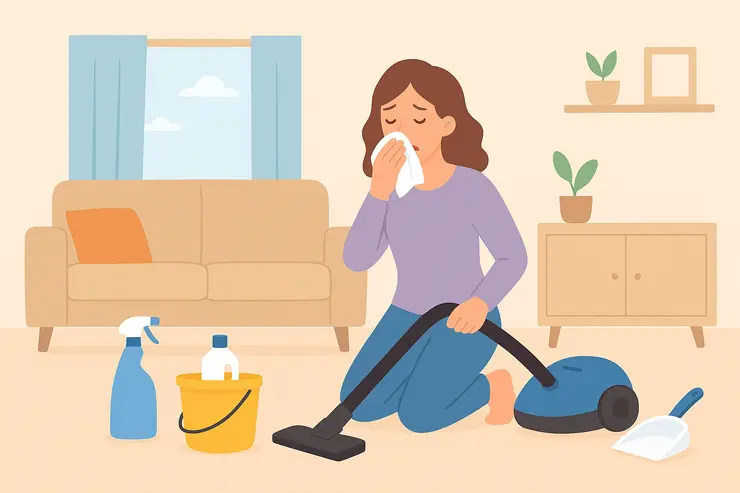Smart Allergy Relief Cleaning Tips for Your Home
Do you tend to sneeze or have stuffiness despite the appearance of the home? Most of the allergics have a hard time maintaining their homes without dust, pollen, and other allergens. The fact is that, to clean the house regularly because of an allergy, one needs a slightly different approach. It is not only about appearing clean, but also about getting rid of all those allergens that are lurking in your home air. Some basic habits and clever cleaning techniques can be used to minimise the number of allergens and make the home a place to breathe and live in even more conveniently.
You will get here useful cleaning hints that would be of advantage to sufferers of allergies. Washing bed sheets properly, ridding of moulds and avoiding heavy perfumes and scents are only some of the measures that will translate to a healthier, cleaner house. We will start with easy and efficient ways of making your home allergy-friendly.
1. Wash Bed Sheets in Hot Water
Your bedroom must be your allergy-free house, but it most commonly becomes the worst place for dust mites in end of lease cleaning. The once-a-week washing of bedcloths and pillow cases in hot water (at least 60 o C) destabilises mites and removes sweat, oils, and allergens. Wash with hypo perfume laundry drink.
Blankets, comforters and pillowcases should also be washed. Cover your pillows and your mattresses with dustproof cover as the mites will not be able to find a place to live in your interior. It is always important to make sure that whatever bedding that you are placing back on the bed is totally dry as moisture promotes the growth of allergens.
2. Prevent Mould in Moist Areas
Bathrooms can also be damp and mould and mildew can easily proliferate. The spores of the mould may cause cough, congestion and difficulty breathing, particularly to individuals who are allergic. To avoid that, do not leave your bathroom wet and stuffy. Switch on the exhaust fan or open a window when there is a shower as a way of letting moisture escape.
Wipe tiles, walls, and mirrors against use to prevent staining from water and moulding. Wash the shower curtains and bath mats frequently – they retain water and easily develop mould. Apply an anti-mould cleaner every one week on corners and grout lines. Additionally, inspect the area of taps or the toilet and repair any leakages. It is also better to keep your bathroom clean and dry to prevent mould before it can spread, and keep the air clean.
3. Vacuum Twice a Week
Some of the most effective methods of reducing allergens in your home are vacuuming regularly. Well, dust, pollen, and the dander of pets get down to carpets, rugs and furniture. When unaddressed, such particles continue spreading in the air and exacerbate the symptoms of allergy.
Twice a week, vacuum your home with a vacuum equipped. Move furniture at intervals to get the dust that is concealed. Users should empty the dust container after use and clean the filter every month to keep the suction power.
4. Clean and Sanitise your Kitchen
The kitchen comes under the category of the busiest places in your home, but it may also conceal food particles, grease and moisture- the ideal environment where mould and bacteria can thrive. To prevent allergens and ensure hygiene is essential to allergic sufferers to have a clean kitchen is essential.
Clean up countertops every day using mild soap or a vinegar/water solution. This eliminates germs without the use of strong chemical fragrances. Take away food waste and cover the trash bin. Wash the shelves in the refrigerator and cleanse away the old food once per week, for health.
5. Skip Fragrant Cleaners
The odour of powerful cleaning agents appeals to many individuals, yet to allergy patients, perfumes will make the condition more severe. Use scentless or natural items. Homemade cleaners are effective and safe. Homemade products destroy dirt and germs without leaving residual harm.
When you buy a product, always read the label first, and buy the products that have no strong fragrance. Replacing the harsh products with the mild ones helps in healthy home suggestions and also renders cleaning safe to all people, particularly those who are allergic or even asthmatic.
6. Proper Filters and good ventilation
The spaces may be hygienic, yet the air may contain allergens in the shape of sneezing, congestion and discomfort. Install your air purifiers and HVAC systems that have HEPA (High-Efficiency Particulate Air) filters that will infer pollen, dust, and pet dander and other minute particles. The vents and filters are to be washed or changed on a regular basis.
Also, one should open windows as much as possible when the weather is favourable to make sure that the air circulates inside the house and the indoor pollutants are reduced. To further prevent, you may also consider using a dehumidifier to dampen down the amount of moisture in the rooms that are highly humid as most of the allergens like the mould, dust mite,s are bound to proliferate in the humid conditions.
Conclusion
Prevention of allergies is not possible most of the time, and a smart and professional cleaning schedule would be significant. Vacuuming often, cleaning the surroundings in which you are staying, washing the bedding with hot water, drying the kitchen and bathroom are some of the steps which will assist in controlling the allergens. Choose the right products that would not only make your home clean but also enable you to remain healthy.

